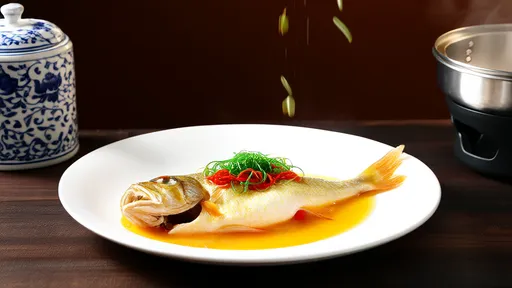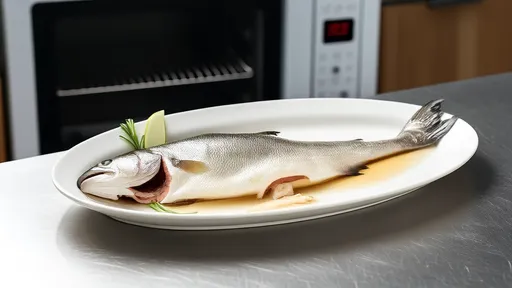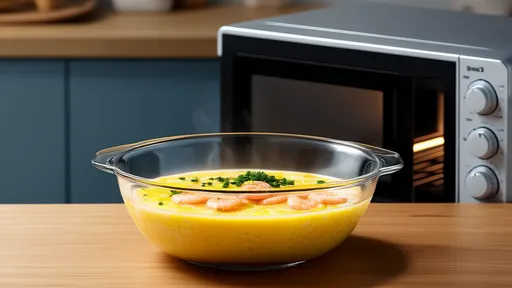Steaming fish in the microwave might sound unconventional, but it’s a quick and efficient method that yields surprisingly delicious results. One of the lesser-known tricks to perfecting this technique is covering the fish with a damp kitchen towel or paper towel. This simple step locks in moisture, ensures even cooking, and prevents the fish from drying out—a common concern when using microwave heat. Whether you’re a busy professional or a home cook looking for a hassle-free way to prepare a healthy meal, this method is worth mastering.
The science behind using a wet kitchen paper lies in how microwaves interact with water molecules. Microwaves heat food by agitating water molecules within it, generating steam that cooks the dish from the inside out. When you cover fish with a damp towel, you create a microenvironment of controlled humidity. The towel acts as a barrier, preventing excessive evaporation while allowing just enough steam to gently cook the fish. This mimics traditional steaming methods, where moisture retention is key to achieving tender, flaky results.
Not all fish are equally suited for microwave steaming. Firm, meaty varieties like salmon, cod, or sea bass hold up best under this method, as they’re less likely to fall apart during cooking. Delicate fish like sole or tilapia can also work but require extra care with timing to avoid overcooking. The thickness of the fillet or steak plays a crucial role too—thicker cuts benefit more from the damp towel technique, as they need longer cooking times without drying out. Always opt for fresh fish when possible, as frozen fillets may release excess water and disrupt the steaming process.
Preparation is straightforward but requires attention to detail. Start by patting the fish dry with a paper towel to remove excess moisture on the surface. Season it lightly with salt, pepper, and aromatics like ginger, garlic, or lemon slices to infuse flavor. Place the fish on a microwave-safe plate and cover it completely with a damp (not dripping) kitchen towel or paper towel. The dampness level is critical—too wet, and the fish may become soggy; too dry, and it won’t generate enough steam. Fold the towel edges neatly under the plate to secure it, creating a loose but effective seal.
Microwave settings vary, but medium power (50–70%) is generally ideal for steaming fish. High heat can cause uneven cooking or toughen the protein. A good rule of thumb is to cook for 3–4 minutes per half-inch thickness of fish, checking for doneness midway. The fish should appear opaque and flake easily with a fork when ready. If undercooked, return it to the microwave in 30-second increments to avoid overcooking. Let the fish rest for a minute after microwaving—the residual heat will finish the cooking process gently.
The damp towel method isn’t just about moisture retention; it also minimizes odors. Fish aromas can permeate a microwave, but the towel acts as a filter, absorbing some of the stronger smells. For an extra layer of odor control, add a splash of vinegar or lemon juice to the water used to dampen the towel. This trick is especially useful in office kitchens or shared living spaces where lingering smells might be a concern. Plus, the citrus or vinegar subtly enhances the fish’s flavor without overpowering it.
Some cooks debate whether paper towels or cloth kitchen towels work better. Paper towels are convenient and disposable, making cleanup effortless, but they must be thoroughly dampened to avoid scorching in the microwave. Cloth towels, while reusable, require careful washing to remove fish oils and odors afterward. Whichever you choose, ensure the material is microwave-safe—avoid towels with synthetic fibers or metallic threads that could spark. Unbleached, natural fiber options are safest and eco-friendlier.
This technique adapts well to global flavors. For an Asian twist, marinate the fish in soy sauce, sesame oil, and scallions before covering it with a ginger-infused damp towel. Mediterranean variations might include olive oil, olives, and rosemary. The steam will carry these flavors into the fish, creating a nuanced dish without added fats or oils. The microwave’s speed makes it easy to experiment with different combinations, turning a simple steamed fish into a canvas for culinary creativity.
Safety precautions are worth noting. Always use microwave-safe dishes and avoid covering fish with plastic wrap, which can melt or leach chemicals into food when heated. Check the fish for bones before cooking, as microwaves can make small bones dangerously hot. And while the damp towel reduces splattering, place a microwave-safe lid or another plate underneath to catch any drips from particularly juicy fish. These small steps prevent mishaps and ensure consistent results every time.
Compared to oven baking or stovetop steaming, the microwave method saves significant time and energy. A fillet that might take 20 minutes in the oven can be ready in under 10 minutes with this approach, making it ideal for weeknight dinners. The energy efficiency is notable too—microwaves use far less electricity than conventional ovens. For those without access to a full kitchen, like dorm residents or travelers with kitchenettes, this technique democratizes access to healthy, home-cooked meals with minimal equipment.
Despite its advantages, microwave steaming has limitations. It works best for individual portions rather than large batches, as overcrowding leads to uneven cooking. The lack of browning means you won’t get a crispy skin, though a quick post-steam sear in a hot pan can remedy this if desired. And while the damp towel helps, microwave steam isn’t as intense as a bamboo steamer’s, so extremely thick cuts may not cook as evenly. Recognize these trade-offs to set realistic expectations.
For those new to cooking fish, this method is forgiving. The visual cue of the towel’s moisture level—it should stay damp but not dry out completely—helps gauge doneness indirectly. Beginners can start with pre-portioned frozen fillets (thawed first) to reduce prep stress. Over time, adjusting cook times and seasonings becomes intuitive. Many home chefs who’ve mastered this technique report that it’s their go-to for impromptu dinners, proving that gourmet results don’t always require gourmet effort.
Environmental considerations come into play too. Using a microwave consumes less energy than traditional methods, reducing your carbon footprint. If opting for paper towels, choose unbleached, recycled options to minimize waste. Better yet, repurpose an old but clean cotton cloth as a dedicated microwave steamer cover. These small choices align sustainable practices with everyday cooking, showing how minor adjustments in technique can contribute to broader ecological benefits.
The microwave’s reputation as a tool for reheating leftovers unfairly overshadows its potential as a cooker of fresh meals. Steaming fish with a damp towel showcases how this appliance can produce healthy, flavorful dishes rivaling more “serious” cooking methods. In a world where time and efficiency are precious, hacks like these bridge the gap between convenience and quality. Next time you’re eyeing that fresh fillet but dreading the cleanup, remember: your microwave and a humble wet towel might just be the secret weapons you’ve overlooked.

By /Aug 11, 2025

By /Aug 11, 2025

By /Aug 11, 2025

By /Aug 11, 2025

By /Aug 11, 2025

By /Aug 11, 2025

By /Aug 11, 2025

By /Aug 11, 2025

By /Aug 11, 2025

By /Aug 11, 2025

By /Aug 11, 2025

By /Aug 11, 2025

By /Aug 11, 2025

By /Aug 11, 2025

By /Aug 11, 2025

By /Aug 11, 2025

By /Aug 11, 2025

By /Aug 11, 2025

By /Aug 11, 2025

By /Aug 11, 2025